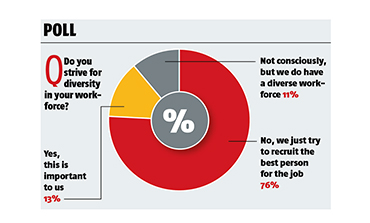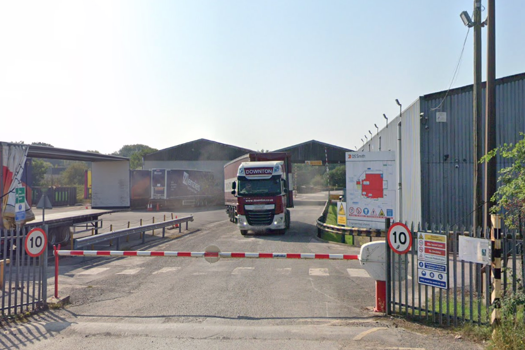At any print show or event, one self-deprecating joke has become more common than any other: inevitably, someone will raise half an eyebrow and observe, wryly, how diverse the crowd is. It is just as inevitable that the comment is sarcastic.
It is as effective a joke as it is facetious. The world outside of print has changed drastically even in the past five years. Black Lives Matter has shed light on institutional racism; #MeToo on misogyny. Whether print has changed is another matter.
In 2016, Printweek talked to some of print’s leading figures from minority backgrounds, to learn the state of the industry. Seven years later, we caught up with two of them to learn whether anything has changed.
“To be honest, it’s really sad: I think it has got worse,” says Gurdev Singh, owner of Northwolds Richardson. The industry veteran has noticed that while public awareness of diversity and inclusion (D&I) in business has only gone up, very little has happened in print.
A recent Printweek poll showed that just 13% of readers were making active efforts to improve diversity in their firms, with 76% saying they only consider aptitude when hiring. Just 11% said they already had a diverse workforce.
“I don’t think it’s to do with peoples’ attitudes, I really don’t,” Singh adds. “I don’t come across anything overtly racist in the industry – people are a lot more aware that there is work to be done. The negative is that I don’t think print has seen any change in terms of the diversity of personnel.”
Asif Choudry, sales and marketing director for creative agency and print firm Resource, is likewise pessimistic. Thinking back to his relaxed stance on the issue in 2016, he has recently grown frustrated with the situation.
“I actually started challenging my old thoughts,” he admits. Choudry had felt the industry – while not that diverse – had more of an issue with attracting young people into the profession.


“I think it still has that challenge, but in terms of bringing more people from ethnic minority backgrounds on board, I’m not sure it has actually moved on.”
He adds: “I would say it has moved on for women – but from our point of view, specifically with the introduction of marketing, design, and creative fields to print – that’s forced that [change], and we’ve seen it in terms of female representation within our own business. But has there been a representation change in the production environment? I’m not sure.”
Print’s problem, according to both Choudry and Singh, is, in part, its image. As Choudry says: “I just don’t know if people from ethnic minority backgrounds or women are actually attracted to jumping on a printing press or a saddle-stitching machine.”
Singh puts it simply: “Print isn’t sexy. There are far fewer young women interested in coming into the trade, and far fewer men of all persuasions. We have an ageing workforce, and we’re competing with other, sexier industries – so we have a lot of hard work to recruit in the first place, and more to recruit diverse personnel.”
Print’s ageing workforce does not just put young people off: for the past few decades, it has actively blocked the entrance of diversity into the industry, according to Brendan Perring, general manager at the IPIA.
To understand why, we need to go back to the 1990s and 2000s, when automation burst into the industry. “The result,” explains Perring, “was the sudden decline in demand for skilled training colleges. It fell apart.”
Print’s main source of young – and increasingly diverse – trainees vanished. At the same time, the industry was rapidly contracting: according to ONS figures, from 2006 to 2021 alone the industry shrunk from 112,000 ‘skilled’ roles to 31,000.
This left a huge pool of experienced candidates competing for fewer jobs. “You could literally throw a stick and hit an unemployed, skilled, print worker. It was no issue finding talent,” Perring adds.
This is a familiar story to Singh. He points out that if a neighbouring print plant closes and you need to hire, “it makes more business sense – and it’s just tempting – to take them on. They’re looking for a job, and you need to fill your skills gap.”
That the talent being picked up was predominantly white and male was not considered an issue. An unremarkable situation at the time, the years have now passed: print’s workforce has stayed white and male, and has got a lot older.
A further complication presents itself, in the fact that while print has contracted, it has not contracted uniformly. While communities still require local print services, the bottom has fallen out of the market in many large-scale print operations, such as newspaper and document printing. Large print operations, like any other manufacturing industry, require plenty of workers – and thus access, typically, to an urban population.
Automation, however, has slashed the number of workers needed to run even a large printing operation; this, coupled with the rise in urban rents and dwindling print spend, has prompted printers to look elsewhere.
Singh observes: “If print companies aren’t in the heart of the city anymore, then it’s hard to recruit from a wide range of ethnic backgrounds. Geography has played a part, but contraction in the industry has been a massive part too.”
These structural issues have left print, in Choudry’s words, possibly even as “pale, male and stale” as it was when he joined the industry in 1995, but that need not be the case.
A combination of Brexit and Covid has, since 2016, rapidly shrunk the talent pools available to the industry, forcing it to consider alternative sources of talent.
Zoe Deadman, managing director of KCS Print, explains: “Managers are being more open-minded to recruiting differently, and looking at transferable skills.”
A second-generation female managing director herself, Deadman has long tried to encourage women onto the production floor.
“Our experience of women in production roles has been largely positive, though we do find that it is harder to convince them to apply for those roles,” she says, nodding to difficult shift patterns and a stigma attached to the male production environment.
Despite her efforts, and those of like-minded printers, the industry will struggle to change without dedicated effort, Deadman acknowledges, pointing out that it will take “significant” work to make print more diverse.
So where is this work? Deadman is complimentary of the BPIF’s efforts to support newcomers to the print industry, both in terms of apprenticeships and awards programmes, but adds: “In order to expand this, though, there needs to be more engagement with schools and colleges.”
The lack of dedicated support schemes for women and ethnic minorities, compared to other industries, is deafening. Something of the type may come yet from the IPIA. In its most recent innovation meeting, the association decided that D&I would be a “key strategic project”, according to Perring.
D&I will become part of the key remit of the IPIA’s new youth members’ council – which it says will have a ring-fenced budget and “real teeth” to create and fund projects.
“We wanted under-25s to make up the council, so they could, without influence, develop initiatives they feel would actually have some impact in this area,” he adds.
The project is, however, in its infancy. There remains a wide-open gap for printers – no matter how hard pressed – to rebuild routes into the industry that have been long-neglected, and secure a diverse succession for print’s ageing workforce.
READER REACTION
What, if anything, can be done to tackle the lack of diversity?
 Zed Sheikh, founder/director, Clifton Packaging Group
Zed Sheikh, founder/director, Clifton Packaging Group
“Diversity has certainly become a key word, and every organisation seems to have criteria to meet. Today, data is king, and we all have to understand that diversity is relative to the talent pool we each have in our own city. 50 years ago, print factories and their workforce were based in the inner city. These inner city sites are now housing blocks, and even larger companies are struggling to attract a workforce. Right now, with interest rates at 8.5%, I would say that survival is more important for printers than diversity. We should rather be addressing issues of diversity and cohesion in schools.”
 Carlotta Maria Basile, production portfolio marketing manager, Canon UK&I
Carlotta Maria Basile, production portfolio marketing manager, Canon UK&I
“Over the last few years, it has become more common to see women at the forefront of the technologies advancing the sector. I experienced this shift during the pandemic; we saw a boom that brought tech industry professionals together. The conversation shifted, and people saw what meaningful contributions were being brought to the table by men and women alike. The advent of social media has been particularly helpful in helping women in print build the next generation of STEM professionals in the industry. However, we need to keep driving awareness, and maximise the chances of attracting new talent.”
 Lascelle Barrow, co-founder and managing director, Augustus Martin
Lascelle Barrow, co-founder and managing director, Augustus Martin
“I’m from an Afro-Caribbean background, and I really haven’t come up against any issues in my career. In 1986 the DSPA decided to put me forward as their representative to Fespa – I found out that I was Fespa’s first black board member, and I became president in 1992. Why would I have been made president, if we had real problems with diversity in the industry? Now when I decided to retire, I had to find a replacement: the best person for the job happened to be a woman. The outside world might have problems with diversity, but in my experience, it’s not an issue in print.”










